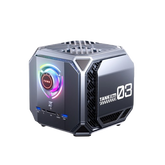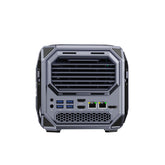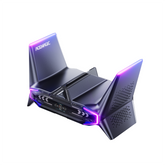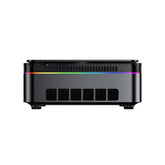The Ultimate Guide to Quad-Display Mini PCs: How to Select Hardware and Setup Secrets

Multi-screen display is an essential productivity booster in today's digital working life. From stock trading to coding, video editing to daily office work, quad-screen display can significantly increase work efficiency. This guide will dive into solutions for achieving quad-screen display with a mini PC, from hardware selection to software configuration, helping you build an ideal multi-monitor workstation.
Why Choose a Mini PC for Quad-Screen Display?
Mini PCs are quickly becoming the modern office essential thanks to their compact size and powerful performance. Compared to traditional desktops, mini PCs offer:
- Space saving: Only about 1/10 the size of a traditional tower --- ideal for compact desks
- Low power consumption: Typically consumes just 10--30W, great for long-term operation
- Quiet operation: Often fanless or ultra-quiet, ideal for noise-sensitive environments
- High portability: Small and lightweight --- perfect for mobile professionals
Hardware Preparation: Choose a Mini PC with 4-Screen Output Capability
To achieve quad-display output, ensure your mini PC meets the following hardware criteria:
1. Graphics Card Requirements
Modern mini PCs typically use one of the following:
- Integrated graphics: e.g., Intel Iris Xe or AMD Radeon Graphics --- some support up to 4 displays
- Discrete graphics: Higher-end models may include mobile NVIDIA or AMD GPUs
- External GPU setups: Via Thunderbolt docks to expand display output
2. Interface Configuration
Verify that your mini PC includes at least 4 of the following interfaces:
- HDMI 2.0 / 2.1
- DisplayPort 1.4 (including USB-C with DP Alt Mode)
- Thunderbolt 3 / 4 (can be converted to DisplayPort)

Connection Schemes: How to Connect 4 Monitors
Depending on your hardware, select the most appropriate setup method:
1. Direct Connection (Best Option)
If your mini PC natively supports 4 display outputs:
- Prepare 4 monitors (preferably of same resolution)
- Use high-quality HDMI or DP cables
- Power on and configure via system display settings
2. USB Display Adapter (Expansion Option)
If your mini PC has fewer than 4 ports:
- Use USB 3.0 / 3.1 to HDMI/DP adapters
- Install the required driver software
- Note: Performance may be limited compared to native outputs
3. Thunderbolt / USB4 Docking Station (Ideal Expansion)
- Use a Thunderbolt 3/4 or USB4 dock (e.g., Caldigit TS4)
- Connect 2--3 monitors via the dock
- Combine with native ports for total of 4 displays
System Settings: Configuring Quad-Screen Display in Windows
Follow these steps to properly configure your 4-monitor setup:
- Right-click on the desktop → select Display Settings
- Click "Detect" to identify all connected monitors
- Drag monitor icons to match physical layout
- Set individual resolution and scaling
- Under "Multiple Displays," select "Extend these displays"
FAQ: Common Questions About Quad-Display Mini PCs
Q: My mini PC only has 2 video ports. Can I still connect 4 screens?
A: Yes. Use a Thunderbolt dock or USB display adapters, but be aware of potential performance drops.
Q: Will four displays affect gaming performance?
A: Yes, especially in multi-screen gaming modes. For gaming, it's better to use one primary display.
Q: Can I mix monitors from different brands?
A: Generally yes. However, syncing resolution and refresh rate improves visual consistency.
Q: What if one monitor is not detected?
Try the following:
- Double-check the cable connections
- Update your graphics drivers
- Use another port
- Reduce the monitor's resolution or refresh rate
Conclusion
With the right hardware and software setup, a mini PC can easily support quad-display output. Whether you're a video editor, financial analyst, or multitasking pro, a 4-screen workstation can dramatically boost your productivity.
Start building your multi-screen workstation today and unlock the full potential of multitasking!







Leave a comment
Please note, comments need to be approved before they are published.